Overview
- Features: Numerous ghats (steps leading to the water) on the western banks of the Ganges
- Opening Times: Dawn to dusk, daily
- Best Time to Visit: Early mornings & evenings
- Duration: Half a day
- Travelled By: Foot
- Cost: Free
- Address: Riverfront, Varanasi, Uttar Pradesh, India
- Type: Ghats
Author Reviews[display_rating_item_results rating_form_id=”2″ rating_entry_ids=”1″ show_category_filter=”false” show_options=”true” result_type=”star_rating” preserve_max_rating=”true” show_title=”false” show_count=”false” ]
Total Rating: [display_rating_result rating_form_id=”2″ show_count=”false” show_rich_snippets=true] [accordions load=”1″] [accordion title=”User Reviews” last] [display_rating_item_results rating_form_id=”5″ show_options=”true” result_type=”star_rating” preserve_max_rating=”true” show_title=”false” show_count=”true” show_rich_snippets=true] [/accordion] [accordion title=”Add Review”][display_rating_form show_email_input=”true” show_comment_textarea=”true” show_name_input=”true” rating_form_id=”5″] [/accordion] [/accordions]
Summary
The hundred or more Varanasi ghats on the river are the main attraction for visitors to this town. Spiritually enlightening and fantastically photogenic, Varanasi is at its brilliant best by the ghats, the long stretch of steps leading down to the water on the western bank of the Ganges.
Most Popular Varanasi Ghats You Should Visit
The hundred or more Varanasi ghats on the river are the main attraction for visitors to this town. Spiritually enlightening and fantastically photogenic, Varanasi is at its brilliant best by the ghats, the long stretch of steps leading down to the water on the western bank of the Ganges. Practically every daily activity is conducted here from ritual baths to washing clothes and from massage to buffalo washing centres.
A boat trip along the river provides the perfect introduction, although for most of the year the water level is low enough for you to walk freely along the whole length of the ghats. It’s a world-class ‘people-watching’ stroll as you mingle with the fascinating mixture of people who come to the Ganges not only for a ritual bath but also to wash clothes, do yoga, offer blessings, sell flowers, get a massage, play cricket, wash their buffaloes, improve their karma by giving to beggars or simply hang around.
Best Time To Visit the Varanasi Ghats
The best time to visit the Varanasi ghats is at dawn (4:30am in summer, 6am in winter) when the river is bathed in a mellow light as pilgrims come to perform puja (literally ‘respect’; offering or prayers) to the rising sun, and at sunset (6pm) when the main Ganga Aarti (river worship ceremony) takes place at Dasaswamedh Ghat.
[singlepic id=378 w=720 h=560 float=center]
How many Ghats in Varanasi?
More than a hundred ghats border the river in Varanasi, but the main group extends from Assi Ghat, near the university, northwards to Raj Ghat, near the road and rail bridge. Covering more than 6 km (4 miles), the Varanasi ghats are lined with temples and shrines that reverberate with the endless cycle of Hindu religious practice – from daily rituals to profound rites of passage.
Famous Ghats in Varanasi
Of the hundred plus ghats in Varanasi, the most famous ghats are listed below.
- Dashashwamedh Ghat
- Manikarnika Ghat
- Assi Ghat
- Ganga Ghat
Varanasi Burning Ghats
Most of the Varanasi ghats are used for bathing but there are also several ‘burning ghats’ where bodies are cremated in public. The main Varanasi burning ghats are listed below. Scroll down the page for more information on each of these burning ghats.
- Manikarnika Ghat
- Harishchandra Ghat
Varanasi Ghats List
Below is a list of the Varanasi ghats along with a description of each ghat as well as some unique and interesting things to look out for.
Southern Stretch of the Varanasi Ghats
Assi Ghat Varanasi (Star Attraction)
[singlepic id=363 w=720 h=560 float=center]
The furthest south of the main ghats, and one of the biggest, Assi Ghat is particularly important as the River Assi meets the Ganges near here making it one of the five ghats that pigrims should bathe from in a day. Pilgrims also come here to worship a Shiva lingam (phallic image of Shiva) beneath a pipal tree.
Evenings are particularly lively here as the ghat’s vast concreted area fills up with hawkers and entertainers. It’s a popular starting point for boat trips and there are some excellent hotels here.
[singlepic id=370 w=720 h=560 float=center]
Anandamayi Ghat
The ashram founded by, the Bengali female saint, Anandamayi Ma, draws thousands of devotees.
Tulsi Ghat
[singlepic id=360 w=720 h=560 float=center]
One of Varanasi’s oldest sites, this ghat (earlier known as Lolarka Ghat), was renamed after the poet-saint Tulsidas, who lived here in the 16th century. His house and temple still stand nearby.
This is the ghat where childless women come to bathe and pray for progeny.
The ghat has fallen down towards the river but in the month of Kartika (October/November) a festival devoted to Krishna is celebrated here.
Jain Ghat
[singlepic id=372 w=720 h=560 float=center]
This ghat has three Jain temples.
Chet Singh Ghat
The fort on this ghat marks the spot where Maharaja Chet Singh was defeated by the British in the mid-18th century.
Shivala Ghat
[singlepic id=361 w=720 h=560 float=center]
This ghat, dating to 1770, was built by Chet Singh, the maharaja of Varanasi. A small Shiva temple and a 19th-century mansion built by Nepali royalty, sit back from this ghat. A lion stands outside the pagoda-style, woodwork Nepalese mansion.
Harishchandra Ghat
[singlepic id=374 w=720 h=560 float=center]
This is Varanasi’s second cremation ghat – smaller and secondary in importance to Manikarnika, but one of the oldest ghats in Varanasi. It also houses an electric crematorium.
Kedar Ghat
[singlepic id=371 w=720 h=560 float=center]
This ghat has a shrine popular with Bengalis and South Indians. It is notable for its red-and-white-striped South Indian-style temple.
Manasarowar Ghat
This ghat was built by Raja Man Singh of Amber and named after the Tibetan lake at the foot of Mt Kailash, Shiva’s Himalayan home.
Chousatti Ghat
[singlepic id=376 w=720 h=560 float=center]
Lessons in the scriptures take place at this ghat, named after the temple of the Chausath Yoginis or 64 female divinities.
Darbhanga Ghat
The towers and turrets of old havelis, built in the early 1900s by two prices of Bihar, dominate this ghat. Some of the massive pillars in these havelis are reminiscent of the Greek style.
Munshi Ghat
[singlepic id=364 w=720 h=560 float=center]
This ghat is filled with beautiful mansions making it a very photogenic ghat.
Ahalya Bai Ghat
This ghat is named after the female Maratha ruler of Indore.
Old City Stretch of the Varanasi Ghats
Dashashwamedh Ghat Varanasi (Star Attraction)
[singlepic id=375 w=720 h=560 float=center]
Situated roughly halfway, this is Varanasi’s liveliest and most colourful and popular ghat and is always crawling with pilgrims, hawkers, and priests surveying the scene from under bamboo umbrellas. This centrally located ghat, Varanasi’s holiest spot, is named after the ten simultaneous horse sacrifices (dasashvamedh) performed by Brahma the Creator.
In spite of the oppressive boat owners, flower sellers and touts trying to drag you off to a silk shop, it’s a wonderful place to linger and people-watch while soaking up the atmosphere.
Every evening at 6pm an elaborate Ganga Aarti ceremony with puja, fire and dance is staged here.
Trilochan Ghat
This ghat has two turrets emerging from the river, and the water between them is especially holy.
Man Mandir Ghat
[singlepic id=368 w=720 h=560 float=center]
Along with the beautiful palace that overlooks it, this ghat was built by Maharaja Man Singh of Amber in 1600. Jai Singh II, who built the Jantar Mantars, converted the palace into an observatory in 1710. Its sundial is visible from the ghat. Hours are 7am to 5:30pm; entrance costs Rs 100.
The northern corner of the ghat has a fine stone balcony.
The Palace of the Dom Raja, the king of the Doms. The Doms are a caste who have exclusive rights over the cremation ghats. They sell wood and collect the ashes. The Dom Raja’s wealth derives from the cremation fees his family have collected for centuries.
Meer Ghat
This ghat leads to a distinctive Nepali temple, which has erotic sculptures.
This is also where the New Vishwanath Temple, Vishalakshi shrine, and Dharma Kupa (where the Lord of Death relinquished his hold over those who die in Varanasi), are found.
Scindhia Ghat
This ghat was originally built in 1830, but the elaborate structures on this ghat were so huge and magnificent that they collapsed into the river and were rebuilt by Daulat Rao Scindhia of Gwalior in 1937. A Shiva temple stands half submerged in the river, with its sanctum knee deep in the water.
Manikarnika Ghat Varanasi (Star Attraction)
[singlepic id=367 w=720 h=560 float=center]
This is the principal and favored shamshan ghat (cremation ground) of Varanasi and the most auspicious place for a Hindu to be cremated. Funeral pyres burn day and night at this cremation ghat, while bodies wrapped in shrouds lie on biers besides piles of wooden logs.
Dead bodies are handled by outcasts or “Untouchables” known as doms, and are carried through the alleyways of the old city to the holy Ganges on a bamboo stretcher swathed in cloth. The corpse is doused in the Ganges prior to cremation. Huge piles of firewood are stacked along the top of the ghat; every log is carefully weighed on giant scales so that the price of cremation can be calculated. Each type of wood has its own price, sandalwood being the most expensive. There is an art to using just enough wood to completely incinerate a corpse.
[singlepic id=369 w=720 h=560 float=center]
You can watch cremations but always show reverence by behaving respectfully. Photography is strictly prohibited.
You’re almost guaranteed to be led by a priest, or more likely a guide, to the upper floor of a nearby building from where you can watch cremations taking place, and then asked for a donation (in dollars) towards the cost of wood. If you don’t want to make a donation, don’t follow them.
Above the steps here is the venerated Manikarnika Kund (well), the world’s first tirtha (tank), said to have been dug out by Vishnu, whose sweat filled it as he created the world as ordered by Shiva. Some say that Shiva shivered in delight when he saw what Vishnu had created, dropping an earring into the pool; others say that it was the earring of Sati, Shiva’s dead wife, hence the name Manikarnika (“jewelled earring”). The Charanpaduka, a slab of stone between the well and the ghat, bears footprints made by Vishnu. Privileged VIPs are cremated at the Charanpaduka, which also has a temple dedicated to Ganesh.
Dattatreya Ghat
This ghat bears the footprint of the Brahmin saint of that name in a small temple nearby.
Northern Stretch of the Varanasi Ghats
[singlepic id=365 w=720 h=560 float=center]
Ram Ghat
This ghat was built by a maharaja of Jaipur.
Pancha Ganga Ghat Varanasi (Star Attraction)
This ghat is empowered by the five mythical streams that flow here into the Ganges, and one of the five tirthas at which pilgrims perform rituals. The ghat has numerous images of the five river goddesses – Ganga, Yamuna, Saraswati, Dhupapapa and Kirana.
[singlepic id=377 w=720 h=560 float=center]
Dominating the ghat is Aurangzeb’s smaller mosque, also known as the Alamgir Mosque, which he built on the site of a large Vishnu temple he destroyed.
Note also the almost submerged cells where the Kashi pundits (priests) are freeze-framed in meditation poses.
Gai Ghat
[singlepic id=373 w=720 h=560 float=center]
This ghat has a figure of a cow made of stone.
Raj Ghat
[singlepic id=362 w=720 h=560 float=center]
This ghat was the ferry pier until the road and rail bridge was completed. This the northernmost ghat in Varanasi.
Tell us what you think. Which Varanasi ghats will you visit? If you’ve been to Varanasi before, which ghats were your favourite and which ghats didn’t you like?
We love to hear from you so please leave your comments below.


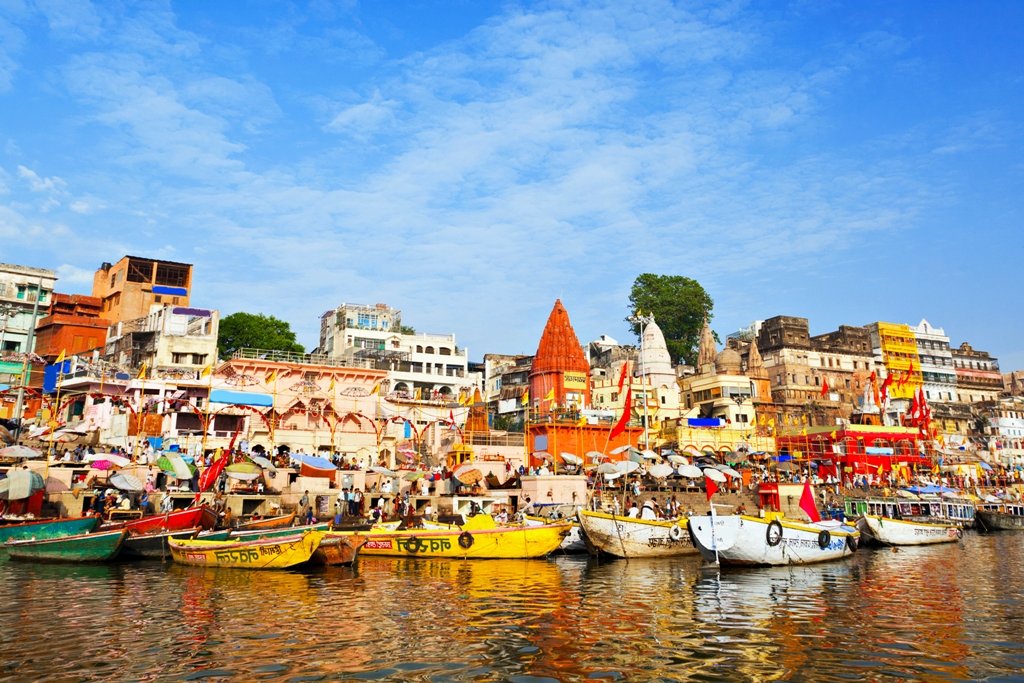
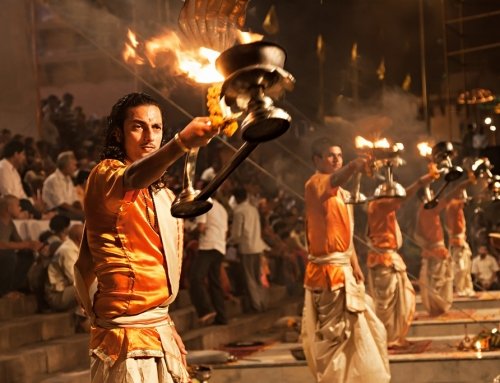
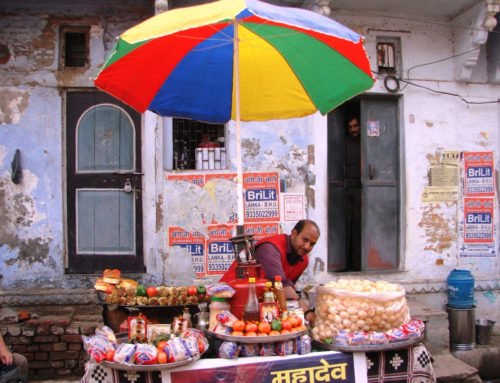
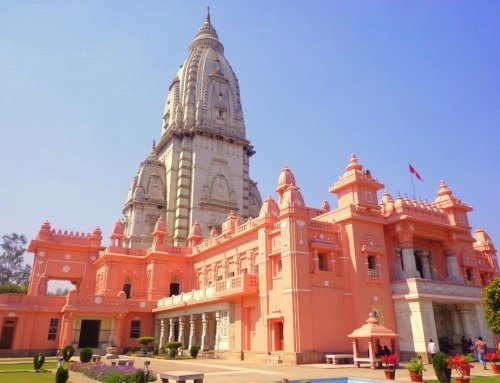
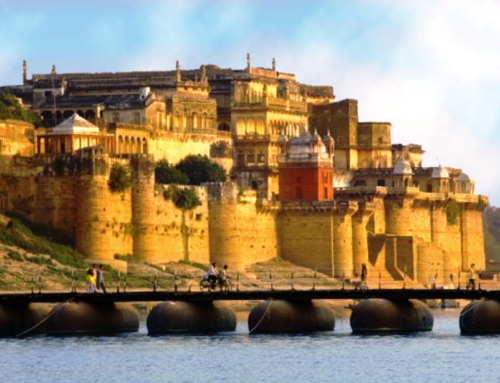

Wow! I can’t believe there are so many ghats in Varanasi. I will put this on my list of places to see in India. Thanks for the info.
Yup, more than a hundred ghats is pretty amazing. Varanasi is one of my favourite cities in India so you should go see it when you’re next in India.